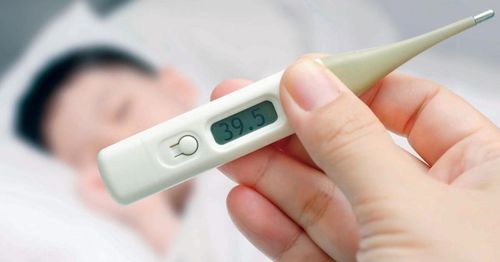This is an automatically translated article.
A persistent smoldering fever is often difficult to pinpoint the exact cause. In case the cause of prolonged fever is tuberculosis, pericarditis, osteomyelitis, intra-abdominal abscess, colon cancer, etc., it is difficult to detect for timely treatment and can cause many problems. dangerous complications for the patient.1. Learn about unexplained persistent fever
1.1 What is a persistent fever of unknown cause? Fever of unknown origin (FUO) is a term used to describe a condition in which a patient has an elevated body temperature (fever) for which no specific cause can be found. This condition is defined by the following characteristics: body temperature higher than 38.3°C (101°F), duration of fever for more than 3 weeks, and no identifiable cause after one week of admission.Fever of unknown cause is classified into 4 categories including:
Classical fever of unknown etiology; Hospital-acquired fever of unknown etiology; Unexplained fever associated with HIV infection; Fever of unknown cause neutropenia. 1.2 Characteristics of persistent fevers of unknown cause Classical fever of unknown etiology Due to infection: Abscess, tuberculosis, endocarditis and complicated urinary tract infection; Connective tissue diseases: Arthritis and polymyositis, temporal vasculitis, systemic lupus erythematosus, Still's disease and rheumatoid arthritis; Due to the appearance of neoplastic mass: Lymphoma, acute and chronic leukemia; Due to drugs: Side effects after using antibiotics, cardiovascular drugs, anti-cancer drugs or drugs acting on the central nervous system; Due to other disorders: Granulomatous disease, alcoholic hepatitis; Due to other undiagnosed conditions.

Bệnh nhân có thể sốt kéo dài nếu bị nhiễm trùng
Effects of surgery, use of urethral and urinary catheters, medical instruments placed in cardiovascular diseases such as coronary stents, bridges, pulmonary artery catheters; Effects from drug use (antibiotic-induced Clostridium difficile colitis); Fever due to the appearance of sores from lying down for too long; Insertion of a nasogastric tube through the pharynx and stomach can cause sinusitis and prolonged fever; Other causes of persistent fever in the hospital: Phlebitis due to deep vein placement, pulmonary embolism, cholecystitis without stones, thyroiditis, reactions to smoking and alcohol withdrawal, infusion reactions, adrenal insufficiency and pancreatitis. Fever of unknown cause neutropenia Patients with leukopenia are often susceptible to fungal and bacterial infections (Candida and Aspergillus, Herpes simplex virus, ...) causing bacterial infections and manifesting as prolonged fever.
Unexplained fever related to HIV/AIDS infection HIV infection is the cause of fever; HIV-associated febrile factors include: Infections caused by Mycobacterium intracellulare, Mycobacterium avium, P.carinii, tuberculosis, Salmonella, Toxoplasma, Cryptococcus, non-Hodgkin lymphoma; Drug fever.

Nhiễm HIV là nguyên nhân gây sốt
2. Symptoms of prolonged fever
Fever symptoms with different types of fever: Continuous high fever, fluctuating high fever, intermittent fever, malarial shivering, low-grade fever in the afternoon, cyclical fever, erratic fever, recurrent fever,...; Symptoms of febrile illness: Manifestations of toxic infection, hemorrhage, jaundice, anemia, hepatomegaly, splenomegaly, lymphadenopathy, rash, bone pain, joint pain, skin lesions, abdominal pain , diarrhea, urinary disorders, cough, shortness of breath,... These symptoms are valuable in orienting to the cause of the disease; Symptoms affecting the whole condition: Anorexia, fatigue, dehydration, digestive disorders, electrolyte disturbances, weight loss, malnutrition, psychological disorders,...3. Prolonged fever is often difficult to diagnose
The diagnosis of the cause of persistent fever in children and adults is important for treatment. However, the cause of persistent fever is often difficult to diagnose because:There are many medical conditions that cause prolonged fever symptoms. In many cases, only fever is the obvious symptom of the disease. Therefore, diagnosing the exact cause of fever is difficult and takes a long time. Usually, prolonged fever is mostly seen in infectious diseases, but also in many medical diseases; Presence of diagnostic factors such as antibiotics overshadowing the typical clinical picture or fever due to drugs can increase white blood cells,...; There are some cases of fake fever, patients with different intentions have faked fever by rubbing the thermometer to make it hot, dipping the thermometer in warm water, burning cigarette butts,...; There are many cases of prolonged fever for which no cause can be found despite being monitored under conditions of modern medical equipment, applying many subclinical diagnostic measures, and staying in hospital for many months.
4. Method of diagnosing prolonged fever

Thăm khám lâm sàng có hệ thống là một trong những phương pháp chẩn đoán sốt kéo dài
5. Treatment of persistent fever

Bệnh nhân sốt kéo dài thường bị thiếu nước nên cần bổ sung khoảng 2 - 3 lít nước/ngày
Should fever be reduced? Fever is a response to help the body fight infections and protect the body. On the other hand, the use of antipyretic drugs can cause blood damage, reduce the body's immunity and resistance to pathogens, obscure the typical picture, and make diagnosis difficult. However, in certain cases, especially in children, a fever that is too high can cause convulsions. Therefore, caregivers can use physical measures such as using a fan, applying heat, avoiding wearing many clothes and using hypothermia and anticonvulsant drugs for the patient as prescribed by the doctor; Add enough water: Patients with prolonged fever are often dehydrated, so they need to add about 2-3 liters of water/day until the urine output reaches 1 liter/day. Adding enough circulating water will help the body reduce heat more effectively; Eat enough nutrients: Patients with prolonged fever often have digestive disorders (loss of appetite, vomiting, diarrhea, constipation, ...) causing rapid weight loss due to protein in the organs being consumed. The higher the fever, the higher the protein requirement, so it is necessary to ensure that the patient eats enough 2,100 - 3,000 Kcal/day. Patients should be given several meals, with priority given to dishes that suit the patient's taste; For the patient to move, sit in a chair for a few hours a day, should not be absolutely immobile to avoid causing thrombosis due to blood clotting; After collecting the complete history, medical condition, symptoms and laboratory data, although there is no definitive diagnosis, it is possible to consider trial treatment of the patient with drugs that treat the underlying cause or mechanism. such as anti-tuberculosis drugs, anti-malarials, antibiotics, anti-inflammatory drugs, ... but should be avoided indiscriminately, in a hurry because it can cause difficulties in diagnosis and treatment later. Prolonged fever can be a warning sign of many dangerous diseases. Therefore, when symptoms of fever do not go away for a long time and recur many times, patients should go to the doctor soon for an accurate diagnosis and appropriate treatment.
For detailed advice about the disease, please come directly to Vinmec health system or book online HERE.
MORE:
What is a persistent fever in children? How should it be handled? Distinguish common fever, viral fever and dengue fever Viral fever in adults lasts for how many days? Do you need to go to the hospital?













